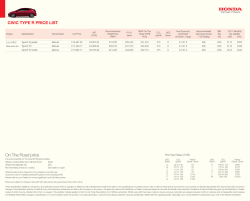
Document 192998
How to improve the long-term competitiveness of the refining system MEDW Conference Jean-Jacques MOSCONI Senior Vice President Strategy & Business Intelligence TOTAL Abu Dhabi, May 9, 2011 Refining: a global trend toward Middle East and Asia 3 Oil demand driven by transport and growth in emerging countries Oil products demand CIS North America 10 Europe 10 30(e) 10 2010-2030 evolution of each segment 30(e) Middle East 10 10 30(e) +26% Petrochemicals +40% Power generation -35% Industry and other -4% China 30(e) 10 South America Transport 30(e) Total 30(e) Asia excl. China Africa 10 30(e) 10 30(e) Increasing demand for light products: naphtha for petrochemicals, gasoline and diesel for transport Increasing need to upgrade refining units to meet the structure change of oil demand 4 +15% Transportation fuels: energy efficiency in the OECD, fleet growth in the emerging countries European Union USA China Mb/d Mb/d Mb/d 10 10 9 8 8 7 6 6 5 Gasoline 4 4 3 2 2 Gasoline+diesel 1 Biofuels Ethanol 0 0 1990 1995 2000 2005 2010 2015 2020 2025 2030 1990 1995 2000 2005 2010 2015 2020 2025 2030 USA : consumption of new cars following CAFE* Europe : new cars consumption following Energy Climate package** *: Corporate Average Fleet Economy, established in Decembre 2007, reinforced by Obama administration **: Established in December 2008 Sources : IEA, US DoE, Total 5 Gasoline The global refining system: new competitors in India, export-oriented refineries Recent development of new refineries in Jamnagar 2 new Indian private refiners Reliance and Essar More than 1,5 Mb/d of new capacities (more than 35% of India capacity) in the Gujarat state Highly competitive refineries Export oriented (export subsidies and no CO2 tax) Reliance Jamnagar refineries Biggest world refinery complex : 1,24 Mb/d : 2 refineries 660 kbd (1999) and 580 kbd (2008) Very complex and flexible (very large FCC, coker, light cycle oil hydrocracker) Essar Vadinar refinery Commissionned in 2008 Current capacity 300 kbd expected to reach 400 kbd by september 2012 Upgrading units will be added with the expansion of capacity 6 Jamnagar, Gujarat The global refining system: China refineries are not exportoriented but meeting domestic demand Main Chinese refineries projects Dushanzi, Petrochina, 200kb/d, 2009 Tianjin Rosneft, Petrochina 51%, Rosneft 49% 260kb/d, 2014 Huludoa, Petrochina 200kb/d, 2014 Caofeidian, Sinopec 200kb/d, 2014 Tianjin, Sinopec 150kb/d expansion, 2009 Chendu, Petrochina, 200kb/d, 2014 Huizhou CNOOC, 240kb/d, 2009 Fujian, Sinopec and Fujian gvt 50%, ExxonMobil 25%, Saudi Aramco 25%, 160kb/d expansion, 2009 Kunming, Petrochina, 200kb/d, 2015 Quanzhou, Sinochem, 240kb/d, 2013 Jieyang, Petrochina 51%, PdVSA 49%, 400kb/d, 2016 Qinzhou, Petrochina, 200kb/d, 2010 Beihai, Sinopec , 88kb/d, 2011 Zhanjiang Sinopec 50%, KPC 50%, 300kb/d, 2015 There are 88 refineries with a total crude distillation capacity of 9.2 mbd by the end of 2010 Chinese refinery capacity is forecast to reach over 12.5 mb/d by 2015 7 The key features of a global competitive refinery Sizable capacity: A minimum size to reach economy of scales Complexity: Ability to deliver high value light products High distillate yield: Adapted to the growing markets with a strong demand for diesel Energy efficiency: Integration of the different units with optimizing energy use Integrated with petrochemicals: Combined optimization of the feedstock streams, sharing units and transfers of products between refining and petrochemicals 8 The Jubail refinery in Saudi Arabia: capturing the conversion margins in the long term Excellent location for both supply and export Optimized supply from Safaniya & Manifa fields (2 Mb/d) Jubail Saudi Arabia TOTAL 37.5% Successful partnership with Saudi Aramco Production start-up Q1-2013(e) : 400 kb/d capacity to treat Arab Heavy Full conversion with high middle distillate yield Integrated with 700 kt/y paraxylene unit Targeting both export and local markets Ideally positioned to meet long term demand 9 But good prospects for strong European refining assets in the medium term 10 Very different situations of the European refineries in terms of capacity and complexity Wide range of refineries in Europe, in terms of size and complexity Only a third of them are over 200 kbd in terms of capacity 20% of them are very simple refineries (usually with a smaller size) kbd Range of distillation capacities of European refineries 450 400 Range of complexity of European refineries Complexity index 14 12 350 300 10 250 8 200 6 150 4 100 50 0 Source: WoodMackenzie 2011 capacity and complexity index 11 2 0 Oil products trade flows: unbalanced Europe 2009 Mb/d 0.7 0.5 North America FSU Europe 0.2 0.2 0.2 3 0.1 Middle East 0.1 Africa 0.1 Gasoline Gas oil South America Total estimates In 2009, Europe: 0.7 Mb/d of gasoline surplus and 0.85 Mb/d of gas oil deficit 12 Asia Pacific The need to be diesel oriented Ability to maximize diesel output Development of distillate hydrocracking (22 existing units, around 15 units projected over the next few years) Likely projects of new distillate hydrocrackers as of 1/1/2011 2.5Mt 1.5Mt 2.3Mt 3.5Mt 1.8Mt 1.6Mt 2Mt 4.6 Mt 13 To be competitive, European refineries need integration with petrochemical plants Exchange of products between refineries and petrochemical plants Main feedstocks : Naphtha LPG Propylene VGO, gas oil and fuel oil Refinery Key products: Hydrogen Low sulphur fuel oil Petrochemical Plant 75% of the European steamcrackers are linked with a refinery 14 Strong regulatory pressure on European refining Potentiel impact level Regulations CO2 ETS • • • • Industrial emission directive Fuel quality directive Water framework directive …/… International Bunker 0.5% S Heating Oil 50 ppm S Jet Sulphur specs SECA Bunker 0.1% S Biofuels 2010 2015 Regulations 15 International Bunker Al+Si < 30 ppm 2020 Product quality Most of the European refineries will have to pay for their CO2 emissions in the ETS Phase3 system Emissions kg CO2/CWT* Ranking of European refineries Emissions of CO2/complexity 10 percentile Benchmark value: Allocation equal to emission performance Average 20% difference with benchmark • As an exposed sector, refining sector is entitled to free allocations based on the performance of the 1st decile of the plants • Methology is based on 98 refineries which have emitted on average 140 Mt CO2/year on 2007-2008. • Comparison with the 1st decile drives to a deficit of around 20% for european refining With the benchmark system adopted for ETS, EU refineries will have to pay as soon as 2013 on average for 20% of their CO2 emissions *: CWT Complexity Weighted Ton Source : Concawe 16 Competitiveness of European refineries will be impacted by CO2 ETS system What system will the European refining sector face for its CO2 emissions ? CO2 allowances (MTe) Free allocations ~140 MT, without atypical units [Progressive application] ~20 % Reduction linked to the benchmark system 2005 PHASE 1 2008 PHASE 2 2013 Immediate application PHASE 3 2020 Cost of electricity self generated or bought by European refining: around 10% of CO2 emissions At a price of CO2 of 25 €/t, ETS system will cost European refineries around 1 billion €/year, including the effect of CO2 on electricity Source: Europia, Concawe 17
© Copyright 2025















